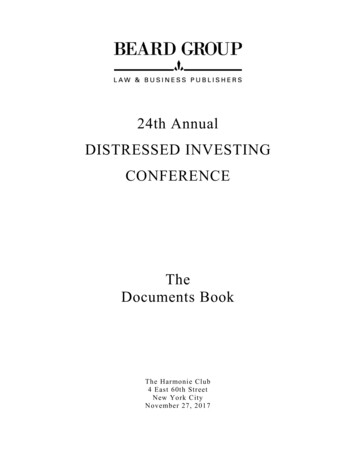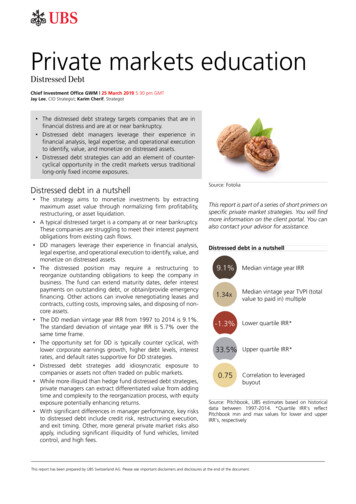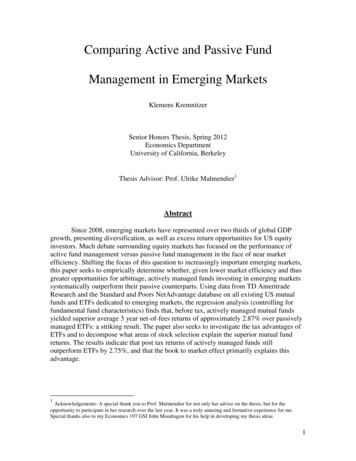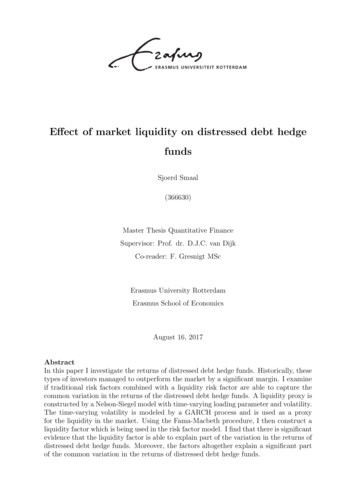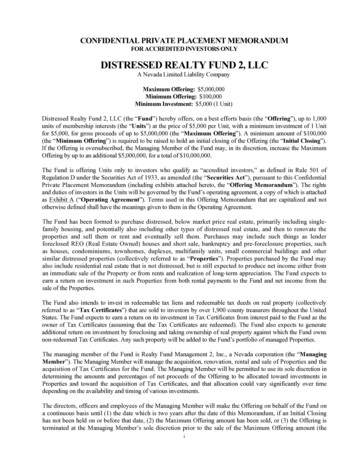
Transcription
EMERGING MARKETS RESTRUCTURING JOURNALIS S UE N O. 2 — FA L L 2 0 1 6Distressed Debt Investing in India—the Use of Debt Aggregation VehiclesBy NIKHIL NARAYANANAlthough the security enforcement landscape in India has historically posed a number of challenges,the market in India is evolving. Recent efforts on the part of the Reserve Bank of India (“RBI”) toencourage Indian banks to clean up their balance sheets has created an opportunity for debt fundsto acquire substantial debt portfolios in India. This, together with recent regulatory changesintended to encourage greater investment in the debt market and to improve the local securityenforcement process, has led to increased inflows of debt capital into India. Much of this investmenthas centred around the acquisition of “distressed debt” portfolios in India and many internationalinvestors have chosen to participate through the use of long term debt aggregation vehicles.6
EMERGING MARKETS RESTRUCTURING JOURNALThere are two potential debt aggregation vehicles in India: assetreconstruction companies and non-banking finance companies.This article discusses the type of debt that asset reconstructioncompanies can acquire, the extent to which internationalinvestors can invest in such vehicles, the normal investmentconsiderations and the benefits that asset reconstructioncompanies offer international investors. It also compares assetreconstruction companies to non-banking finance companiesin the distressed debt context and considers the impact of therecently enacted Insolvency and Bankruptcy Code 2016 onsecurity enforcement by such debt aggregation vehicles.Background to the use of debt aggregationvehicles in India“Distressed debt” in the Indian contextInvestors seeking to participate in the debt market in India donot need to do so through debt aggregation vehicles. Indeed, mostmezzanine debt or mezzanine-style investments are structuredas bespoke secured bond investments through instrumentsknown as “non-convertible debentures”. Whilst this structureprovides access to the capital of highly levered companies, itdoes not provide direct access to portfolios of distressed loans(although these bonds could themselves become distressed ifthey suffer an event of default). In contrast, debt aggregationvehicles provide for immediate and direct access to portfoliosof distressed loans.In this regard, distressed debt has a particular meaning. It refersto debt which has failed certain RBI default guidelines. In India,debt is usually regarded as being distressed when, in the RBI’sparlance, it is an “SMA-2 account”, meaning that payment underthe loan is more than 61 days overdue. This is the point at whichit can be sold to asset reconstruction companies (see discussionbelow) and the debt is treated as “non-performing” whenpayment is more than 90 days overdue.Borrowers of this nature are often in need of significantrestructuring. That is also true of distressed investmentselsewhere in the world, but in the Indian context, a successfuloutcome for an investor often requires the cooperation of thecontrolling shareholder as well as the borrower’s managementand labour force. Indeed, the RBI sees the role of private capitalas being able to absorb this debt from the banks and to workwith the borrowers rather than to undertake “asset stripping”.This does not mean that security is unenforceable or that the RBIwill obstruct creditor action to protect its rights, but that theRBI will expect investors to have a plan in place to re-schedulethe debts and enforce security (amongst others). Therefore,investors seeking to invest distressed debt in India are lendinginto this construct.IS S UE N O. 2 — FA L L 2 0 1 6—Two potential debt aggregationvehicles in India: asset reconstructioncompanies and non-banking financecompanies.Benefits of debt aggregation vehiclesin this contextApart from providing access to distressed debt, the mainbenefit of using debt aggregation vehicles is that certain ofthem benefit from certain enhanced security enforcementtools in India under the Securitisation and Reconstruction ofFinancial Assets and Enforcement of Security Interest Act,2002 (“SARFAESI”). SARFAESI allows certain lenders toenforce security or take certain other measures to protect theirinterests without any judicial intervention. These include theright to change the management and to take over the securedassets to realise their value without judicial intervention. Inlight of the difficult security enforcement regime in India, theseremedies are seen as being desirable by international debtinvestors. The provision of SARFAESI have been strengthenedby amendments in 2016, which extend its benefits to certainbond instruments as well.Whilst it is certainly helpful for an investor to have these toolsin its armoury, historically, lenders have had mixed successin using these provisions in practice. Therefore, if this is theonly reason for the use of a debt aggregation vehicle ratherthan a more bespoke investment structure, then investorsshould consider this aspect of emerging market enforcementrisk carefully, i.e. this is not a silver bullet that addresses allenforcement risk in India. In addition, although this is generallyconsidered to be a welcome measure for creditors, the newlyenacted Insolvency and Bankruptcy Code 2016 (“BankruptcyCode”) does adversely affect SARFAESI (and indeed, that isthe intention). The Bankruptcy Code, as a matter of policy, isintended to replace individual creditor enforcement actionswith a collective creditor enforcement process upon the onsetof insolvency. It achieves this through a moratorium that restrictsSARFAESI rights during the insolvency resolution process(discussed further later in this article). The effect of thismoratorium is more pronounced in relation to debt aggregationplatforms (in comparison to certain other SARFAESI qualifying lenders). Therefore, SARFAESI rights should not be thesole determining factor in an investor’s decision to set up orparticipate in a debt aggregation platform.7
EMERGING MARKETS RESTRUCTURING JOURNAL—Asset reconstruction companies(ARCs) are the most commonlyused debt aggregation vehicle, asfar as pure distressed investmentsare concerned.In addition, there are certain tax advantages in relation to theuse of certain debt aggregation vehicles, as discussed furtherbelow.Asset Reconstruction CompaniesWhat is an ARC?The most commonly used debt aggregation vehicle, as far as puredistressed investments are concerned, are “asset reconstructioncompanies” (“ARCs”). The term ARC does not refer to a specialtype of legal entity in itself, but to a registration with the RBIunder SARFAESI. ARCs act as managers to the security truststhat actually acquire the distressed debt portfolio. The securitytrusts then issue security receipts in relation to the underlyingdebt acquired.Investors will also need to consider their overall investmentobjectives in this regard. An ARC is required under SARFAESIto only undertake “asset reconstruction” activity (unless it hasreceived RBI approval for any other activity). Therefore, if aninternational investor intends to lend more widely, then theremay be other structures that are more appropriate.International participation in the equity and themanagement of ARCsInternational investors now benefit from greater flexibilitythan in the past.Historically, international investors were subject to a numberof restrictions both in relation their investment in the equityof the ARC itself as well as a cap on its holding of securityreceipts. However, recent changes to India’s foreign directinvestment policy and SARFAESI mean that internationalinvestors can now invest in up to 100% of the equity of ARCs(although any investments of above 10% will require the investorto also satisfy the “fit and proper” person test and hold all thesecurity receipts in any tranche.1 Of course, that latter point isaffected by the separate RBI requirement for ARCs to hold8IS S UE N O. 2 — FA L L 2 0 1 615% of the security receipts which is discussed further underthe heading “Issuance of security receipts” below. The changesmean that there is no longer any regulatory reason for aninternational investor to seek a local partner. That said, someinvestors have chosen to retain a local partner to assist with localsourcing of opportunities and management of local regulatoryand diligence issues (see discussion under the heading“Regulatory and operational issues” below).International investors are free to appoint directors andstructure the governance of the ARC as they wish (providedthat these arrangements comply with Indian company law),although the RBI does impose an incremental layer ofregulation. Some of this relates to ensuring that the directorsare appropriately qualified with the right level of experience.However, any “substantial change of management”, which isdefined to include the appointment of any director or managingdirector or CEO of the Asset Management Company, willneed the RBI’s approval.Acquisition of distressed debt portfolios by thesecurity trustThe debt is required to be of a certain regulated grade ofdistress before ARCs can seek to acquire them. The RBIrequires Indian banks to classify debts using certain codes.Debts which are overdue over 61 days can be sold to ARCs(these are called “SMA-2 accounts”, where the debts are61-90 days overdue and “non-performing assets” where thedebts are more than 90 days overdue). In addition, debtswhich are part of a consortium loan, 75% of which is“non-performing” (as defined above) can also be sold to ARCs.With that background, there are two ways for an ARC to acquiredistressed debt: (a) by participating in a public auction process(discussed further in the paragraph below); and (b) throughbilateral arrangements (these are directly between the holder ofthe debt and the purchaser and it is not common for these salesto involve a third party). The former is more common and theRBI is seeking to introduce greater transparency to this process.The RBI’s main concerns in this regard are to ensure that buyersundertake proper diligence (and its regulations have enablingprovisions allowing buyers two weeks to conduct their duediligence) and to ensure transparency. It is also focussed onensuring that the auctions result in real sales of distresseddebt, rather than being a price discovery exercise alone. To thisend, in guidelines issued on 1 September 2016 (“DistressedDebt Sale Guidelines”), the RBI has set out detailed requirements encouraging the use of electronic auctions, requiringthe banks to indicate the discount rate that they are usingand to put in place policies to sell debt through the “Swiss
EMERGING MARKETS RESTRUCTURING JOURNALChallenge” method (where the failure to sell results in thebank having to put in place higher bad debt provisioning).Recent amendments to SARFAESI mean that the acquisitionof distressed debt by an ARC will not be subject to stampduty (although stamp duty will apply when one ARC sells anydistressed debt to another ARC).IS S UE N O. 2 — FA L L 2 0 1 6of security receipts) rather than paying out cash. However,the RBI is seeking to discourage this practice in its recentDistressed Debt Sale Guidelines, by imposing higher provisioning requirements on the banks in such circumstances. 4Ability of the ARC to transfer or syndicate its securityreceipt exposureFrom a risk mitigation perspective, any debt investor will wantIssuance of security receiptsthe ability to exit its investment by selling down its exposureAn ARC will be required to formulate a policy (to be approvedat any time (particularly since the credit default swap marketby its board) relating to the issues of security receipts by itsin India is currently quite limited). Equally, the ARC may wishsecurity trust. The security trustee will then be required toto syndicate its exposure at the outset. With regard to investprepare a scheme for thements made by an ARC inissuance of security receiptssecurity receipts, whilst thereand the RBI’s Securitisationis no “lock-in” period, thisIllustration of an ARC structureCompanies andis possible subject to certainManagementReconstruction Companiesconstraints.fee(Reserve Bank) GuidelinesARCand Directions 2003 (theFirstly, there is the 15%“RBI 2003 Guidelines”)“invest and hold” requirementCashInsurance of 15% of thepaymentsecurity receiptscontemplate the preparationon the part of the ARCH inPayment of cash orof an offering document. Therelation to each tranche ofissuance of up todisclosure in this document issecurity receipt. ARCs cannot85% of the securityreceipts as considerationquite basic and, to date, theretransfer this stub holdingSecurityis no regulatory frameworkrequirement.BankTrusteefor the listing of securitySale of debtreceipts.Secondly, the sale can onlybe to other “qualified buyers”Original loanThe security receipts have a(this is required to be a termPayment obligation andnumber of features thatof the security receipt issubenefit of security transferedbenefit investors. They areance scheme under the RBIBorrowerrequired to have a credit2003 Guidelines). Of course,rating, which is based onit may be the case that thesetheir net asset valuequalified buyers constitute(“NAV”). The rating is to bemuch of the addressableon a “recovery rating scale” and the RBI has set out a number ofmarket, but before undertaking any sale, this is a point that anrules governing this rating (including the disclosure of anyARC will want to check.conflicts of interest). Also, there is no minimum maturityperiod in relation to the security receipts. In addition, followingThirdly, the drafting of certain exchange control provisionschanges introduced in 2016, security receipts benefit fromcreates some regulatory ambiguity in relation to the ability of“pass through” treatment with regard to the coupon and anyforeign portfolio investors (“FPIs”) to acquire security receiptsredemption premium payable on the security receipts issuedin the secondary market (i.e. not directly from the issuer).by securitisation trusts (there is withholding in India, butFPI status is a securities registration allowing internationaltreaty benefits will apply).2investors the ability to participate in the Indian securitiesmarket. Historically, this has been one of the simplest waysfor debt investors to hold Indian high-yield securities. TheThe RBI requires the ARCs to acquire 15% of the securitydefinition of “qualified buyers” includes a reference to “ foreignreceipts so that it has direct “skin in the game”, but otherwise,institutional investors”. Since that was the regulatory predecesthe security receipts can be issued to “qualified buyers”.3 It issor of FPIs, that does not cause concern. The issue of concerncommon practice for a security trust to acquire distressed loanarises from the fact that the drafting of the relevant provisionsportfolios from banks and issue them with 85% of the trancheof RBI’s Transfer or Issue of Securities Regulations 2000of security receipts (so that the ARC holds its required 15%9
EMERGING MARKETS RESTRUCTURING JOURNALsuggests that as far as non-primary acquisitions are concerned,FPIs can only participate if the security receipts are listed. Todate, there is no mechanism to list security receipts. Indeed,the Securities and Exchange Board of India (“SEBI”) regulations that introduced the FPI concept do not refer to listedsecurity receipts. Therefore, this seems to be an inadvertentregulatory oversight that ought to be capable of beingexplained to the RBI, but it would be prudent for an ARC toseek RBI guidance on this at the outset to avoid facing issueslater.Funding of ARCsThe funding of ARCs requires careful consideration at theoutset. Equity funding is the default position, but will an ARCbe able to “leverage” itself by capitalising itself with debt (i.e.can an ARC leverage its 15% security receipts holding)?As an initial gating question, any ARC will need to considerto what extent this such leverage will be consistent with RBI’sguidelines (which envisage the ARC retaining skin in thegame). Beyond that, all Indian companies are subject to a number of restrictive RBI rules on “external commercial borrowings”and ARCs would not ordinarily qualify as permitted borrowersunder that. That said, there may be other bond instruments(such as “non-convertible debentures”) which may be capable ofbeing used.Synthetic exposureAnother question that international investors sometimes consider is their ability to hedge themselves by creating derivativeinstruments outside India based on the Indian underlyingdebt (i.e. the debt portfolio acquired). In general, SEBI, India’ssecurity regulator, very carefully scrutinises any such arrangements which it refers to “off-shore derivative instruments” andits FPI regulations permits the creation of such derivativeinstruments if the underlying securities are either listed or are“to be listed”. Since the security receipts are not listed instruments (and there is no framework to do so), that will impose arestriction in practice.Commercial arrangements in relation to the ARCThe RBI closely regulates a number of the commercial aspectsof the functioning of an ARC.10IS S UE N O. 2 — FA L L 2 0 1 6—A Non-Banking Finance Company(NBFC) is a company that providesfinancial services in the Indianmarket (which may include lendingand, if so permitted, deposittaking too).The RBI requires the ARC’s management fees to be calculatedas a percentage of the net asset value based on the lower endof the NAV range indicated by the credit rating agency (ratherthan being based on the outstanding value of the securityreceipts). In addition, the fees cannot exceed the acquisitionvalue of the distressed loan portfolio acquired. Managementfees are to be recognised on an accrual basis.The RBI also regulates the treatment of a number of accounting matters. For example, with regard to pre-acquisitionexpenses (e.g. due diligence), the RBI requires these to beimmediately expensed in the profit and loss statement for theperiod to which such costs relate. There are also detailed provisions with regard to post-acquisition cost expensing. Theseguidelines also regulate matters such as revenue recognition(including on yield, upside income and management fees) andthe accounting treatment of security receipts in the hands ofinvestors. Therefore, any investor seeking to invest in thesesecurities should carefully study these rules to understandthe accounting implications as an initial regulatory diligencematter.Regulatory and operational issuesARCs are regulated entities and this comes with its owncompliance requirements, including a number of periodicfilings with the RBI. Well advised lenders will also want to keepa close eye on their portfolio and so this does mean that settingup an ARC will require an effective local presence in practice.Outsourcing arrangements are unlikely to be practical hereand it also seems unlikely that the RBI would accept this outside of certain defined boundaries. For this reason, a numberof international investors have chosen to partner with Indiancounter-parties who are more familiar with the regulatorylandscape.
EMERGING MARKETS RESTRUCTURING JOURNALNon-Banking Finance CompaniesIn addition to ARCs, another form of lending vehicle that isused in the domestic context is the “non-banking financecompany” (“NBFC”). An NBFC is a company that thatprovides financial services in the Indian market (which mayinclude lending and, if so permitted, deposit taking too). NBFCare closely regulated by the RBI, which imposes a number ofprudential capital norms. They are broken down further into anumber of categories, deposit-taking and non-deposit takingand systemically important and non-systemically important.In addition to the RBI guidelines, there an overlay of foreigndirect investment regulations that adds an additional layer ofregulation for international investors.Is this a suitable vehicle for distressed debt investment?NBFCs are commonly used for general financing transactionsin India and the number of NBFCs currently in existence isfar greater than the number of ARCs. However, despite that,NBFCs have historically not been the default choice of vehicleto undertake distressed debt investments. Part of that reasonis that until September 2016, there were certain restrictionson NBFCs that had received international investment. Thoserestrictions have been removed, so the issue does now meritcloser scrutiny.IS S UE N O. 2 — FA L L 2 0 1 6The main benefit of NBFCs is that they are able to undertakea broad range of finance activities and have access to accountsbefore they reach the 61-day default stage (which is when ARCscan acquire such debt). This means that they are able to acquireand aggregate debt that has a better chance of recovery. NBFCscan also borrow outside India, subject to certain conditions,unlike ARCs (which are not permitted to borrow under India’s“external commercial borrowings” exchange controls).However, there are a number of tax disadvantages to the useof NBFCs. Any instruments they issue will not benefit fromtax pass through treatment (unlike security receipts issued byARCs). Also, any distressed debt that NBFCs acquire will besubject to stamp duty as the exemption recently introduced toSARFAESI in 2016 only applies to acquisitions by ARCs.From an enforcement perspective, the right to enforcesecurity without the approval of the courts under Section 13of SARFAESI has recently been extended to certain NBFCsthat have a capital of INR 5 billion, roughly 75 million atcurrent exchange rates (and where the secured debt is at leastINR 10 million, or about 150,000 at current exchange rates).However, other provisions of SARFAESI, such as the “deemedassignment” (by operation of law) of any distressed debts donot apply to NBFCs and they only apply to ARCs. Of course,ARCS can benefit from contractual assignment, so this maynot be the most significant disadvantage in practice, but it is apoint of difference.11
EMERGING MARKETS RESTRUCTURING JOURNALIS S UE N O. 2 — FA L L 2 0 1 6ARCs v NBFCsA more detailed comparison of ARCs in comparison to NBFCs is set out below.ConsiderationARCNBFCPermitted activitiesLimited to asset reconstruction activity,i.e. suitable for the acquisition of distressed loan portfolios but not widerlending.NBFCs can undertake a broad range oflending activities as permitted by the RBI.Restrictions affectingforeign investmentNone.Previous restrictions under India’s foreigndirect investment regulations have nowbeen eased on in September 2016.However, any depending on the nature ofactivity being undertaken, the regulationsof other regulatory bodies (e.g. the RBI) maybe relevant.Need for RBI registrationYes.Yes.RBI approval for changeof managementYes for substantial changes of management (appointment of a director, managingdirector or CEO). Shareholders holding10% or more of the shares of an ARCmust be “fit and proper” persons.Yes for the following: (a) takeover or changeof control (regardless of whether or not itresults in a change of management); (b)the transfer of 26% of shares in the company;or (c) a change of 30% of the board (excludingindependent directors).Subject to prudential capital orcapital adequacy requirements?Yes (the 2003 RBI Guidelines).Yes (there are detailed and separateguidelines on these).Stamp duty on acquisition ofdistressed debt portfolio?No (there is an exception underSARFAESI).Yes.Debt capital instruments that itcan issue (other than convertibleinstruments)Security receipts and non-convertibledebentures (there is no explicit restrictionin relation to the latter).Non-convertible debentures and “masalabonds”.It is currently unclear as to whether theRBI will accept ARC issuing “masalabonds” and practice is yet to evolve inthat regard.Ability to borrow outside India(outside the instruments referredto in the row above)?No, ARCs are not permitted to borrowunder India’s “external commercialborrowing” exchange control rules.Yes, NBFCs are permitted to borrow under“Track 3” of India’s “external commercialborrowing” exchange control rules.Pass through tax treatment oninstruments issued?Yes on security receipts issued byan ARC.No.Benefits from SARFAESI enforcementprocesses (Section 13)Yes.Yes for NBFCs with assets of over INR 5billion and provided the security interestsecures a debt that has a principal of atleast INR 10 million.Benefits of deemed assignmentprovisions under SARFAESIYes.No.12
EMERGING MARKETS RESTRUCTURING JOURNALImpact of the bankruptcy code on bothARCs and NBFCsIndividual v. collective enforcement processesARCs and qualifying NBFCs which benefit from SARFAESIwill be equally affected by the advent of the recently enactedBankruptcy Code, which, at the date of publication of thisarticle, is not in force.SARFAESI constitutes debt recovery legislation, which enablescreditors to enforce individual rights. In contrast, the BankruptcyCode establishes a collective insolvency procedure by imposinga UK style quasi administration regime for insolvency companies.The inter-relation between the two laws will need to establishitself in practice, but there is an obvious tension here.Moratorium on SARFAESI actionUnder the Bankruptcy Code, once the insolvency processcommences, a moratorium is imposed upon creditor rights.This restricts not only current and potential legal proceedings,but also rights under SARFAESI. Section 14(1)(c) of theBankruptcy Code states that the moratorium applies to “anyaction to foreclose, recover or enforce any security interest”including under SARFAESI. That begs the question as towhether the rights to replace management under SARFAESIwould be affected. The language here is not as clear as wouldhave been ideal and there may well be some exploitation of thisgap in the future, but the legislative intent is clearly to restrictsuch type of action as well.Therefore, if a creditor initiates the bankruptcy process (byapplying to the court), the moratorium will take effect andany secured creditors cannot stop this from taking effect andSARFAESI action will need to come to a halt and be replacedby the collective insolvency procedure. Of course, ARCsand NBFCs will be part of the creditor committee which ispart of the insolvency process, where decisions need to beundertaken by with a 75% majority (by value and includingunsecured creditors). This may give ARCs and NBFCs someleverage to affect the outcome of the insolvency process.LiquidationThe insolvency process is time bound (180 days extendableby no more than a further 90-day period) and if there is noresolution during that time, the default is for the company tobe liquidated. In such circumstances, any secured creditors(including ARCs and NBFCs) can elect to receive proceeds inliquidation (by relinquishing their interest to the liquidationestate) or stand outside this by informing the liquidatorIS S UE N O. 2 — FA L L 2 0 1 6and directly enforcing their security interests. Therefore,SARFAESI may play a role in enforcement in this regard.Will the Bankruptcy Code weaken the attraction ofARCs and NBFCs?Although, ARCs and NBFCs still hold other advantages forinvestors (for example, by providing access to distressed debtin India), their attractiveness may be affected by the BankruptcyCode, once it comes into force and once the institutions andprofessional bodies that it contemplates come into existence.In order for ARCs and NBFCs to be able to utilise their SARFAESIrights, they will need to have initiated and completed theirSARFAESI sales prior the occurrence of an insolvency trigger(non-payment of debts when they are due and payable). ARCsand NBFCs are only permitted to enforce after the debt hasdefaulted by certain periods and after then have given theborrower certain further notice periods. In practice the companyis almost inevitably likely to be insolvent by the time they areable to exercise their rights, which will dilute the value of theirSARFAESI rights.This dynamic should, in practice, encourage investors toinvest in distressed debt through the qualifying permitted debtinstruments (which also benefit from SARFAESI), because theevent of default in these cases does not need to be tied to thedebt being “non-performing” (i.e. having been significantlyoverdue).However, it remains to be seen as to how this dynamic playsout in practice, particularly still the institutions and eco-systemneeded to make the Bankruptcy Code a success will undoubtedly take time to evolve. During this interim period, SARFAESIwill continue to be a useful tool.Alternative Investment FundsBackgroundOther than ARCs and NBFCs, some investors have alsoconsidered the use of “alternative investment fund” (“AIF”)registrations to establish their credit platforms in India. AnAIF is a fund pooling vehicle that is incorporated or establishedin India and is registered with SEBI. AIFs can receive investmentfrom investors both inside and outside India. There are differentcategories of AIF registrations which are subject to differentinvestment restrictions, but “Category II” AIFs are permittedto make debt investments and hence this provides anotherroute for international investors to access debt capital issued byIndian companies.13
EMERGING MARKETS RESTRUCTURING JOURNALPros and consHowever, AIFs do not benefit from any special enforcementtreatment. Also there are restrictions on the ability of CategoryII AIFs to leverage themselves and so such AIF vehicles do havetheir limitations. But provided they are properly structured,as the law currently stands, Category I and II AIFs do benefitfrom tax pass-through treatment and this has been one of theirattractions.Some Closing ThoughtsThere is no doubt that debt aggregation vehicles do offer anumber of advantages for investors seeking to engage in a longterm basis in the distressed debt market in India, particularlyin an enforcement scenario. It is also clear that ARCS currentlyoffer a greater range of bene
ensuring that the auctions result in real sales of distressed debt, rather than being a price discovery exercise alone. To this end, in guidelines issued on 1 September 2016 ("Distressed Debt Sale Guidelines"), the RBI has set out detailed require-ments encouraging the use of electronic auctions, requiring
